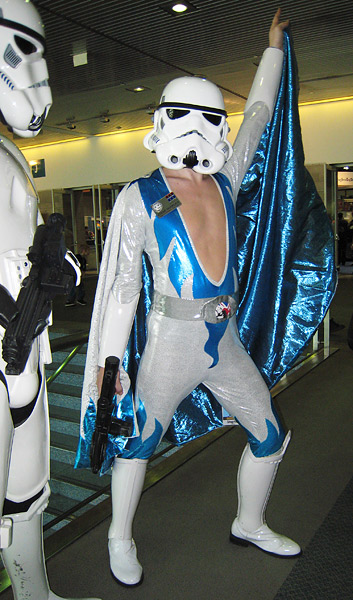Posting here has been light this winter quarter because I've been steamrolled by winter quarter, the most intense three months of first year film school. We're broken into three groups of seven, and each of us here at school is given one Thursday through Sunday block to direct a six page short. The weekends we aren't directing we crew for each other. We rotate through being director, assistant director, director of photography, gaffer/grip, assistant cameraperson, sound mixer, and boom operator.
I'm through all but of the film shoots for the quarter and I'm so tired that my mind suffers occasional lockups, almost like mental blue screens of death. To stay awake on set, I've invited all sorts of vices back into my life: coffee, which I have abstained from for about eight years now; Coke (the liquid soda, mind you), which I almost never drink; Mountain Dew, which I haven't had since I was in high school; and one cigarette, which I had to toss after two drags as an experiment gone awry.
The caffeine hasn't been a good idea. It overpowers my exhaustion and forces me awake really early every morning no matter what time I climb into bed. Right at this very moment my body's energy tank feels like it's at 30%, just dying for some REM sleep, but instead I've just been lying on my sofa half awake for a half hour. I feel like Stellan Skarsgård in Insomnia.
We're limited to a 12 hour shoot each day, but when you include equipment load and unload at the start and end of each day, we're working 16, 17, sometimes 18 hours days. When you include a day of set building and a day to strike the set on the front and back ends of shoots, and when you add in equipment rental pickups and returns, transportation to and from sets, there's almost no slack time for anything other than showering and sleeping (and for some, the former is a luxury). My group production professor recommended that once shooting started, we schedule every life maintenance task, from doing laundry to taking out trash to getting a haircut to brushing our teeth. The most mundane things fall by the wayside when in production.
A seven person crew is a skeleton crew on 16mm film projects, even ones as short as our student films. If you're shooting a documentary on a camcorder with natural light, no actors to rehearse, no sync sound to record, no sets to build, then a one or two person crew is sufficient. But on a narrative film project, when there's a camera to maintain, film to load and download, lights to set up and strike, light readings to measure, actors to outfit and touch up, focus to pull, sound to record, light to shape and control, marks to set, sets to build, among countless other tasks, then a seven person crew feels light.
Throw in the fact that many people are learning these roles on the job and you have the formula for some long, stressful, chaotic days. Someone serving as a gaffer for the first time is going to work about 20% as efficiently as a professional gaffer, and the productivity is even lower when you consider that on a student shoot you might have a lone gaffer dealing with a dozen or more lights for a setup. Whereas on a professional shoot you might have an assistant camera person (AC) to pull focus and guard the camera, a second AC to lay marks and grab focus measures, and a loader (to track, load, and download film magazines), on a student shoot you have one AC who handles all those duties. Every task takes longer, and the error rate for novices is higher.
Our professors instruct to be patient with our classmates and to treat these first year films as learning exercises, but the truth is that most no one treats their films that way. You see your classmate sink a huge portion of their life savings into these projects, you see the effort they put into their script, into finding locations and actors, in dealing with bureaucracy and rejection, you see them scream and cry and argue, and you can't help but feel the pressure when you're crewing on their shoot. Adding the mental stress to the physical exertion of the long work days, I can't recall too many more draining four day stretches in my life than each of our shoots.
You'd think that with the larger crews on a professional shoot every thing would feel more chaotic, but it's the reverse. If you've ever wondered why the end credits of a major motion picture scroll on for five minutes at movie's end, and I've certainly had that thought in the past, working on a student production sends you a long way towards an answer. If you can find a specialist for every task, someone who is an expert at that task, and their sole responsibility is to handle that task, then the director has one fewer ball to juggle. If you have an art director who snaps photos so you can maintain prop or costume continuity from one shot to the next, or a script supervisor to track eye lines, then you as the director can focus on other, more important issues, like performance.
Clean division of labor makes for more efficient communications and a less stressful shoot. On student shoots you'll see overzealous directors trying to direct actors, search for props, move set pieces, set frames in the eyepiece, move lights, all in the span of a few minutes. Every one wears several hats, and that model doesn't scale up to a longer shoot.
The downside of having a Hollywood-sized crew is one of cost and logistics. If an exterior shoot gets rained out, every one still gets a paycheck. On a student shoot, where many if not most of the cast and crew are unpaid, a starving student director has to eat a few more weeks of ramen. Getting a huge crew to location and finding parking for all of them is not easy. If you want to shoot a scene at your apartment to save on location costs, it's far easier to do with a compact student crew than a professional crew where you have to find space for every department.
The positive to being on set for so many consecutive weeks is that it launches you up the learning curve of film production with neck-snapping acceleration. At least it has for me. I'm many years removed from my undergrad days, but I feel like a freshman again, even though I'm so much older than some of my classmates that they call me dad. I enjoy film theory classes and watching classic movies as much as anyone, but I suspect that stories of Quentin Tarantino going from video store clerk to big-time director merely by watching lots of movies while at work have filled too many heads with the idea that film consumption and appreciation alone is enough to get you 90% of the way there.
The best way to learn to make movies is to make movies. The best way to learn to write is to write. The best way to become a great surgeon is to perform hundreds of surgeries. The other key element is the feedback loop. Sitting in a dark telecine room with a colorist, watching the footage from your shoot for the first time, is an amazing experience. All the correct decisions and mistakes you made on set are in your face, right on screen, and they become part of your filmmaker's intuition on the next shoot.
I thought it would be difficult at this point in my life to start over in a profession. For most of my life my peers have been a bit older than me, but that time has passed. What hasn't changed is this: I've never gone wrong when choosing the darker tunnel with the bright distant light than the more well-lit hallway with the no discernible alluring endpoint. Follow your interests and you will always have the joy of your work to sustain you. I often hear people say there are jobs they couldn't take because the job title isn't palatable to them anymore. It's one of the strongest lock-in traps out there.
When you make a change in profession, though, a lateral job move just isn't the norm. If you let your first career trajectory set the course for the rest of your life, you're severely limiting the amount of information on which you base one of the most important decisions in your life. I wish I could claim to be one of those people who was making brilliant home movies at age six with his father's super 8 camera, but I wasn't. I never contemplated being in the film business until just five or six years ago. It's not a profession I had any exposure to during my youth, or in college, or even right out of college.
The most dangerous temptation that leads people astray is money. My first job out of college was in consulting. It paid pretty well, and with some school debt in my past, saving up some cash provided a warm and fuzzy feeling. Being able to eat out at nice restaurants, see a movie whenever I felt like it, purchase the hardcover edition of a book, and travel around the world was a refreshing change from college days. But there was only one problem: I didn't enjoy my work. I looked at the partners above me and realized very early on that I didn't want to end up like any of them. I also learned a valuable economics lesson about high-paying jobs. There are some jobs that pay really well because only a few people can perform them (major league baseball player, for example). However, most high paying jobs pay a lot to generate demand. Otherwise no one would do them for life. Consulting is one of those jobs that gradually increases your pay so that you always have enough to adjust your lifestyle higher but never have enough to retire on.
I am lucky, and rather spoiled. Though my parents helped to put me through college, they never forced me to take any job for money or prestige. Even before heading out to school, my mom in her heart of hearts wanted me to head east, to a certain famous, prestigious school. I decided to go west instead, and they never said a word to change my mind. The stereotypical Asian parent encourages their child to go down the pre-med route as an undergrad. By "encouragement" I mean "brute force." My parents didn't force that on me, and I never drifted that direction. I decided late in school to double major in English, and despite having to pay extra for some summer schooling to make my requirements, they were behind me a hundred percent.
When I graduated undergrad, I had another chance to head out east to my mom's favorite school, but I deferred and went to work instead. I was burned out on school. She was behind me a hundred percent. Then I decided not to go back to school at all and to take a huge paycut to go to Amazon, and though it raised some eyebrows, again they helped me to make the move. And though my mom wasn't around when I made the decision to leave Amazon and try to pursue filmmaking, I'm pretty sure if she were she would've been on my sets this year, cooking, putting up lights, chatting with my actors, and keeping my set tidy.
My rule of thumb has always been to try to find work that is enjoyable four days out of five. I'm not sure there's a job out there that is fun all the time. Hard work is required and so it's dangerous to wait around until you find something you love to do all the time. However, if you're you're not excited to get out of bed and go to work at least three out of five work days, you should aim higher.
I'm rambling. This hasn't been my most coherent post, but I'm not at my sharpest right now. It's been an incredibly instructive quarter. But Mr. Demille, I'm ready for my spring break.
Technorati Tags: filmschool, movies







